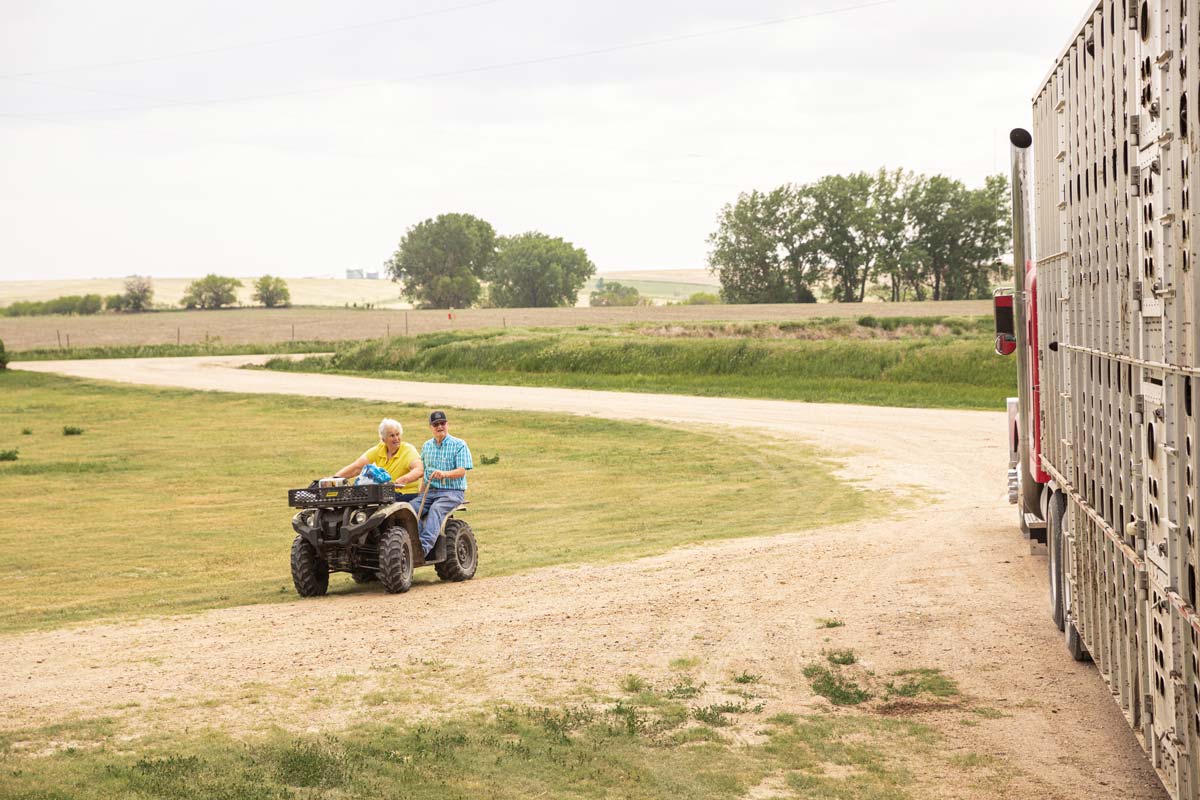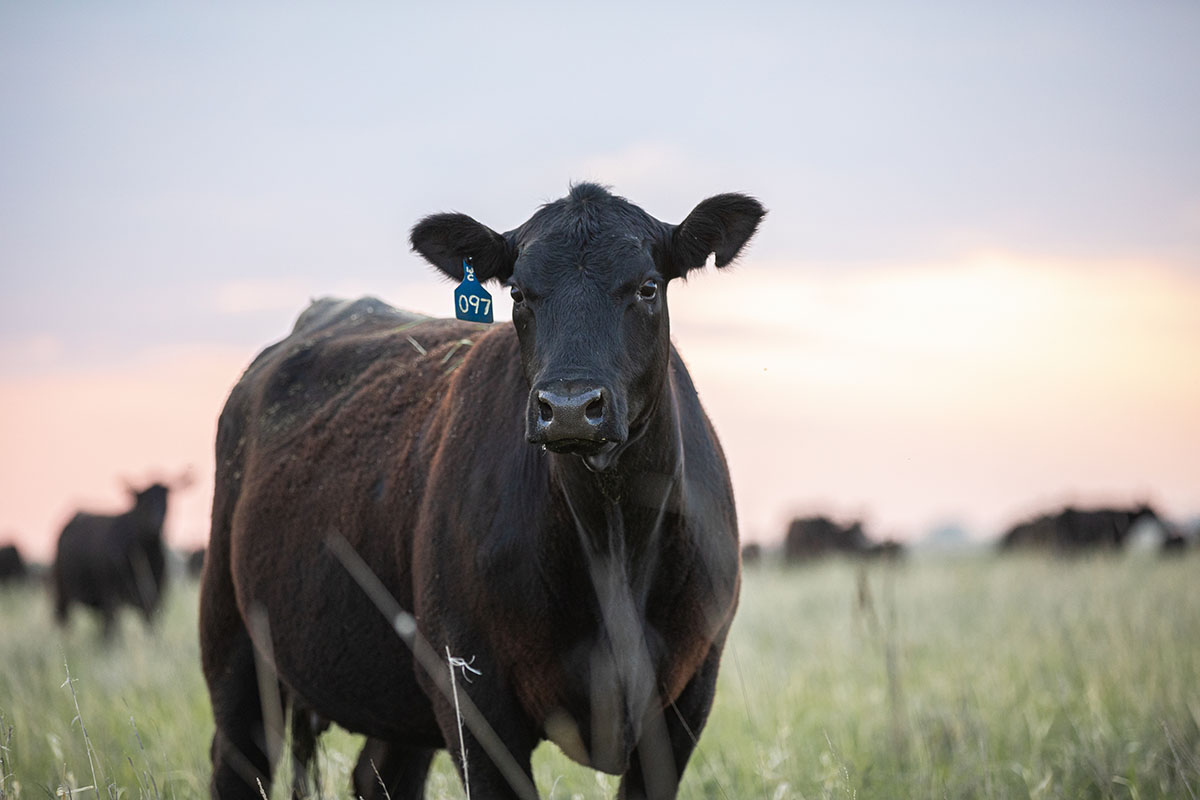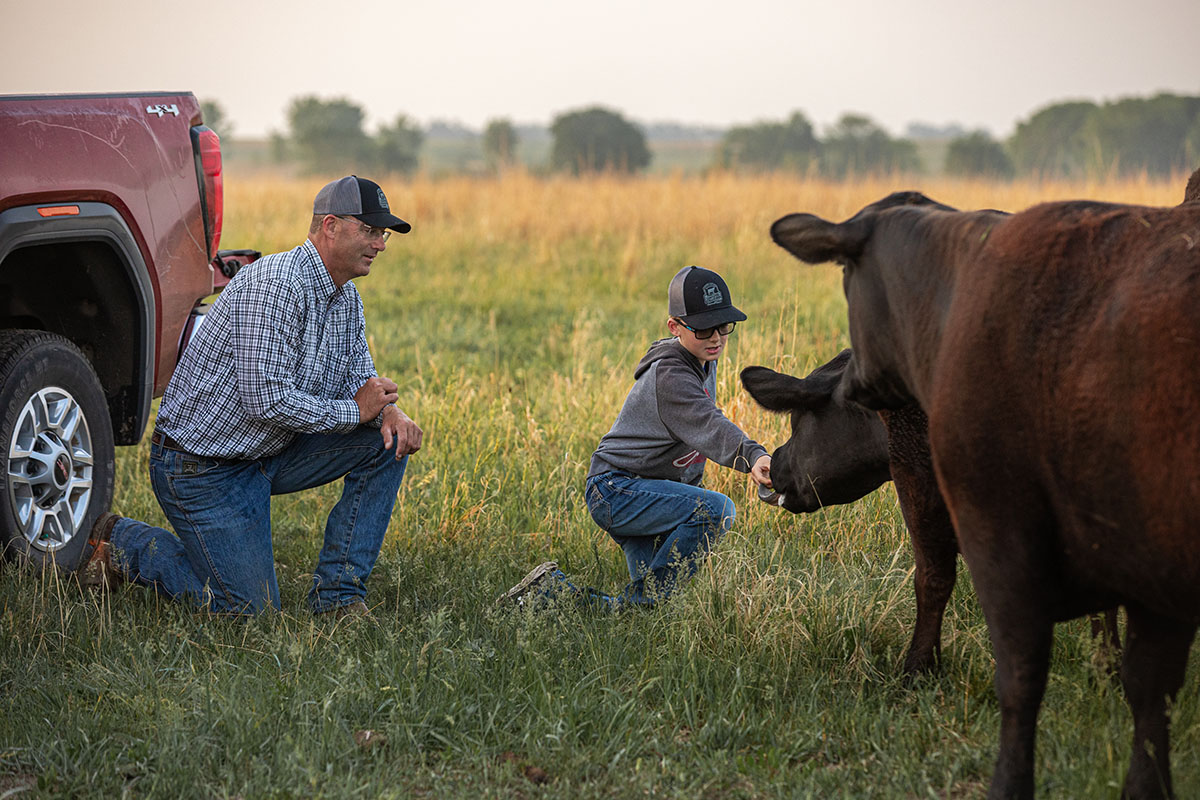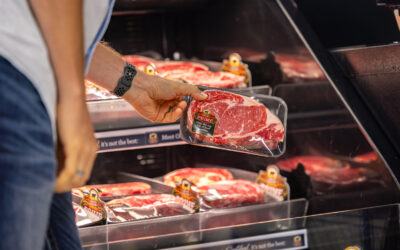
Everything They Have
For giving it their all, Anderson Cattle receives Certified Angus Beef commercial producer award.
By Morgan Boecker, Senior Manager of Producer Communications
October 2023
If snapshots in scrapbooks could talk, they’d tell of both the good and the hard times the Andersons have seen.
Burning the old milk barn so a new calving and horse barn could be built. A framed shed ready for metal before a storm knocked it to the ground to push restart. Or just daily life on a ranch with four kids, and now a growing bunch of grandkids.
To see it live, Anderson Cattle tells a story of hard work.
Progress is a necessity on the Guide Rock, Nebraska, ranch where Troy Anderson manages a commercial Angus herd, small grower yard, his 10-year-old son, and a testing environment.
The first picture you see when arriving are thoughtful buildings and pens designed to make it easier on the livestock and people.
“It all goes back to efficiency,” Troy says. “The more comfortable the cattle are, the higher possibility of that calf grading better and growing better in the feedyard.”
His focus is clear: maternal cows that thrive in his environment, big calves that will grade premium Choice and Prime. But his approach includes respect for his livestock, people and land. For that, Anderson Cattle was honored with the Certified Angus Beef (CAB) 2023 Commercial Commitment to Excellence Award. Troy, son Zane and parents Roy and Rosemary received the award in September at the CAB Annual Conference in Las Vegas.
Long-term Priorities
Quality has been a priority for the Andersons even when CAB launched in 1978. When they heard of a premium beef brand looking for Angus cattle, they called to find out where they could take a load of calves.
“I just remember shoveling corn and shoveling corn and shoveling corn,” Troy says.
Then, finishing calves took manual labor scooping corn into a wheelbarrow to pour into a wooden bunk. When the calves were ready in the summer of 1980, they were hauled to Litvak Meat Company in Denver.
“We did really well with them,” Roy recalls: 64 percent qualified for the new Certified Angus Beef ® brand.
They sought better genetics through bull sources and being selective for replacement heifers. Looking for Targeting the Brand™ logos in bull sale catalogs is an easy tool to use.
“Targeting the Brand tells me a bull has the genetics to produce a higher percentage of calves that qualify for the CAB,” Troy says. That’s his target, too.
Bulls also have to check the box for efficiency, growth and ribeye area.
Today, loads of cattle far outnumber their first pen of fed calves in 1980. Loads now often average 90 percent Choice and Prime with more than half hitting CAB. The few Select grades can be traced back to a problem in that calf’s life, Troy says.
“We’re bottom-line driven,” he notes. “If we can get an extra $6 per hundredweight, that’s $50 to $60 a head. That can be the difference between making money or not on a set of calves, especially with the things we’ve gone through the last few years in the cattle industry.”
It just made sense to build a yard to grow and finish calves at the ranch. Since 2015, Troy has fed and finished home-raised, purchased or customer cattle in his 850-head feedyard. All are marketed on a quality-based grid.
As soon as he gets the carcass data back, he’s matching sires to electronic identification tags to see if the bulls will get used again next breeding season. Data and technology are keys to improvement.
“Harvesting more CAB qualifiers not only gives us more profit, but it helps consumers feel better about beef,” Troy says. “It also makes me feel better about our cattle, knowing that we’re producing beef that people want and enjoy.”
And consumers can feel better because the cattle raised according to Beef Quality Assurance guidelines relate not only to product in the grocery meat case but to the entire herd.

Caption: On shipping day, truck drivers are greeted with blueberry coffee cake, cinnamon rolls or brownies from Rosemary.
Meeting Cows Needs
Reaching higher quality grades starts with taking care of your cows.
“Our Angus cows have to give calves a good start by getting them up and nursing,” Troy says. “But it’s up to us to make sure the cow has what she needs to make good colostrum.”
That’s just the start. If a calf gets even a little sick or develops lung problems, its performance is affected.
The pressure is on the females to do their job. He keeps sound, moderate size cows that can raise a big calf and breed back over the years for longevity.
“There’s always been the desire to raise good cattle and do a good job with the cattle we have,” Troy says.
Selection for better cows started with Roy.
“He had 35 cows when we got married in 1970,” Rosemary says. “We could never get more than 40 because either lightning would strike one or something would happen. That’s just the way it was.”
Gradually, they grew their herd until it was the main focus, which led Roy to artificial insemination (AI) school in the ‘80s.
“After that, we kept the AI heifers because you could pick them out of the herd, just bang,” Roy says. “They were the bigger, nicer ones.”
They AI’d 100 heifers and 150 cows last spring, a herd that’s dwindled in the face of too many consecutive dry years.
Waterlines run across 600 to 1,000 feet of surface to get water to cows lucky enough to be on grass. Others were fed longer and kept dry lotted well into the summer.
“It’s a testament to Angus cows and careful management,” Troy says. “We’ve pushed them for efficiency but upped our mineral program to make up for the differences.”


Easier and Better Today
Rundown fences, eroded farm ground and a dream lay before Roy when he moved to Nebraska in 1963. That snapshot in time is long gone, after days of putting in terraces, planting trees and replacing fence.
The couple started out farming wheat, milo and silage while ranching on the side. As the kids grew in number and the weather was dry, Roy would pick up some dollars custom farming or working shifts at the Superior dehydrating plant making alfalfa pellets from midnight to noon.
“I’d sleep two to three hours, get up and work for me a while, then go back to work,” Roy says. “Rosemary was getting pretty aggravated, but it’s all worked out.”
Other days he would spend nearly 24 hours swathing or baling hay. “That was probably the hardest work I’ve ever done,” he recalls.
The days were long and the work physically exhausting.
Troy moved home in 2001 to help Roy with a large custom hay assignment that first summer, and he started a fencing business. Extensions of the work he was doing on their ranch.
“We put in miles and miles of cross fence and several miles of waterlines to tanks,” Troy says.
The new system distributed the cows’ grazing, resulting in better grass. It makes life a lot easier for herd and pasture, especially during a drought, he adds. Cows will graze more areas of the pasture when they have access to fresh water.
Memories of progress bring a smile. It isn’t easy passing the reins to the next generation, but Troy says his parents have been accommodating to let him make decisions and learn from them.

Caption: “We are all BQA certified,” Troy says. “It helps consumers feel good about what they’re buying and feeding their families and shows them we’re doing everything the best that we can at the ranch.”
Strength Together
The cattle may determine what’s on today’s to-do list, but people are the heart of the operation.
It takes the same firm, yet gentle hand to be a stockman and a dad. Lessons Troy learned the hard way guide him as a father today when he has Zane in tow.
“I like to help sort cattle because you can learn a lot about them,” Zane says. “Dad taught me to be calm around livestock because they can sense you. So, if you’re angry or happy, they can sense that.”
“I learned how to handle cattle really well because we had a lot of electric fence growing up,” Troy says. “To have Zane out there wanting to learn, it means the world to me thinking I’m raising someone who may help move the industry forward.”
While age may be slowing down Roy and Rosemary, food brings everyone together at least once a day. They sit down and enjoy meals, even if it’s wrapping up a hamburger and delivering it to where Troy, Zane and their part-time hired hand are working.
“I believe it is very important for families to take that time together,” Rosemary says, “just one look, or dinner conversation, to know how the day went.”
Everything they accomplish, they accomplish as a family.
“We have lived here 50-some years now,” Roy says, “and we’ve got everything situated about the way we want it.”
While pictures taken today would stir envy in many ranchers, those 10 years from now will build on successes. They’ll continue to give everything they have to get better.
“Mom has scrapbooks where you can see pictures of what it used to be like,” Troy says. “Our progress and what we’ve built here, I’m pretty proud of that.”
This story was originally published in the Angus Journal.
You may also like
CAB Sets Sales Records, Sees Historically High Brand Acceptance Rates
In an otherwise tough time in the beef business, sales and supply records have been a bright spot. The positive numbers mean that quality beef production has not let up, and beef demand is holding. Consumers have proven the value proposition: the good stuff is worth a little more money, for a better eating experience.
Feeding Quality Forum Dates Set Earlier in August
When you’re feeding cattle, it counts to keep track of every calf, pound and dollar. Beyond the event’s educational sessions, networking between segments of the beef supply chain is invaluable—from feeders and cow-calf operators to allied industry and university researchers.
Gardiners Highlight Service, Strength at Foodservice Leaders Summit
Mark Gardiner and his son, Cole, of Gardiner Angus Ranch offered a boots-on-the-ground perspective for CAB specialists attending the annual event, designed to deliver resources that help train foodservice teams and serve consumers at a higher level.



